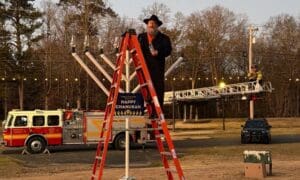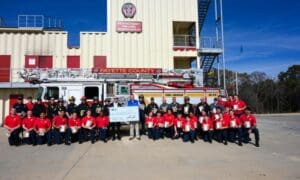EMC CEO deems power restoration process ‘extremely efficient’
The winter storm that hit Fayette and Coweta counties beginning the night of Feb. 11 and extending over much of the week was not one that carried the bitter cold seen two weeks earlier. Dwarfing the ice and snow problems were the power outages that accompanied the storm, with thousands of Georgia Power and Coweta-Fayette EMC customers without electricity for hours or days.
It was late Wednesday afternoon, the first full day of the winter storm, that the two electricity providers reported 7,417 customers in Fayette and 5,253 in Coweta without power. Only hours earlier on Wednesday the two companies had 9,700 Fayette customers and 4,700 Coweta customers without power.
Representatives of both companies talked about issues they faced during and after the storm.
Coweta-Fayette EMC President Tony Sinclair in assessing EMC’s response said, “Considering the magnitude of the ice storm on our over 6,100 miles of line and the damage sustained, we believe that the restoration process was extremely efficient. We are proud of the tremendous work that was done by all of our employees. They truly care about our members.
“Coweta-Fayette EMC plans for emergencies and disasters routinely during the year. Coweta-Fayette EMC maintains and updates often our written (ERP) Emergency Response Plan. Our ERP covers specific storm and emergency action plans, personnel storm schedules, call center operations procedures, supply vendor contacts and contract line crew contacts, communication planning, FEMA (Federal Emergency Management Agency) requirements, etc.
“We also routinely practice tabletop exercises during the year to simulate different disaster scenarios to maintain a high degree of preparedness at all times.”
Sinclair said Coweta-Fayette EMC has mutual aid agreements with other cooperatives and utilities which provides the company with the ability to obtain significant assistance from others when needed. EMC on Monday, Feb. 10, arranged through its statewide organization to obtain line crews totaling 191 line workers from several electric cooperatives in Alabama, Mississippi and South Georgia and contract line crews from Indiana to assist, Sinclair said.
“Out of town crews began arriving early Tuesday morning. We assigned Coweta-Fayette EMC personnel to the crews from other locations to facilitate coordination, efficiency and for the safety of all personnel. No personnel were injured during the massive restoration effort which is a tribute to the planning and conscious effort to work safely while working 16-18 hour shifts. Line crews worked around the clock,” Sinclair said of the effort of line crews in replacing power lines to 75 poles broken during the storm.
Customers of both power companies experienced understandable difficulty getting through to customer service representatives given the volume of outages. Aside from the the extremely long wait times, some of EMC’s customers complained that they received varying answers on repair progress and found the outage map on the company’s website to be inaccurate.
“We had around 21,000 outages at our highest point and many were reoccurring outages as a result of new trees falling on lines that had already been repaired,” Sinclair said. “The tremendous call volume of an outage of this magnitude is always handled best by our IVR (Interactive Voice Response System) automated phone system which can handle large volumes of calls and automatically transfer the outage information to our outage management system. We also had a full staff of Coweta-Fayette EMC customer service representatives answering calls live as well as our overflow phone provider CRC (Cooperative Response Center) whose customer service representatives also handled outage calls.
“We plan to review in great detail the storm communications information and determine if there are any potential enhancements or opportunities that would improve service to our Members. Continuous improvement is something that is part of our work ethic,” Sinclair said.
Pertaining to some of the concerns by customers over the company’s outage map not accurately reflecting the status of their home, EMC Vice President of Marketing Mary Ann Bell said the map does not always pinpoint a particular location.
“Outages get placed on the map after the report of the outage comes in. And once a repair is made it has to be verified and then input into the system,” Bell said of the lag time required to accurately reflect the status of both outages and repairs.
EMC is currently in the process of assessing the cost associated with the damage from the storm. As for plans that might help mitigate long outage periods in future storm events, Sinclair said, “Our Coweta-Fayette EMC personnel always prepare for the worst and hope for the best. We are always ready and prepared with highly-skilled and professional employees and we embrace new technology whenever it benefits our members.”
Georgia Power spokesperson Carol Boatright said Monday that last week’s winter storm was one of the three worst events of any kind in Georgia that the company has responded to in terms of the restoration of power and damage to equipment.
Boatright said the company is still compiling cost figures from the storm. She said there were more than 8,000 linemen and others responding throughout Georgia. Those figures included more than 3,000 from eight other states, with efforts after Wednesday centering on south metro Atlanta and east Georgia.
South metro Atlanta, including Coweta, Fayette, Henry, Clayton and south Fulton counties, had 229,000 customers without power, while statewide Georgia Power had approximately 701,000 customers affected by the winter storm, said Boatright.
Boatright said Georgia Power utilizes a triage methodology when responding to outages. The first priority is to restore service to facilities such as public safety, hospitals and water treatment plants. The second priority calls for restoring power to the greatest number of customers compared to the time spent in restoration. Under that methodology, a subdivision with 1,000 homes without power would have a priority over a subdivision with 100 customers, Boatright explained.
Looking back at the winter storm, said Boatright, the company tried to position crews based on weather projections.
“We were pretty close and we repositioned crews as needed,” she said.
A frustrating factor during the ice storm was one where power was restored at one location yet within minutes or hours another tree would fall across power lines and cause another outage.
“We had to restore some locations multiple times,” said Boatright.
Fayette County Administrator Steve Rapson in providing an assessment of the winter storm response said he would give the county and the many agencies and organizations involved an overall “A” grade.
“Everybody pulled together as an extremely cohesive team,” Rapson said. “And it was a whole combination of folks.”
As in any emergency, it would be expected to have public works, public safety and county staff communicating with state and local assessment and response agencies, such as the Ga. Dept. of Transportation and the National Weather Service, and to coordinate local response efforts. But there were other organizations and individuals playing a significant role during the weather emergency.
Among those were Piedmont Fayette Hospital, faith-based organizations and retired weather service staff, Rapson said. Fayette Middle School also served as a temporary shelter during the power outages that occurred during the storm.
The efforts were coordinated through the emergency operations center which Rapson said operated as planned.
Though the storm response was successful, Rapson said the county will be looking at ways to improve further during future events.
Fayetteville City Manager Joe Morton addressed the city’s response efforts. For Morton, it took only three words to relay the effects of the planning and execution of those plans.
“The words that come to my mind concerning our local response to the storm are preparation, responsiveness and coordination,” said Morton.
Peachtree City Police Chief H.C. “Skip”Clark also weighed in on the efforts of police officers and others in responding to the storm.
Clark said when viewed from an overall perspective he thought the response by the city’s public safety personnel was excellent. Clark said the response effort included officers, CERT (Community Emergency Response Team), most of the internal auxiliary and a number of reserve officers.
Clark said the department worked with public services staff, the fire department and the public to help with “chain saw teams” clearing fallen trees and cleaning cart paths.
A large part of the response was communicating with the public, using social media and communicating with local news outlets to identify areas of concern and to urge motorists to stay off the road, said Clark.
In total, Peachtree City during the ice storm had two traffic accidents, four road closures and 78 calls for fallen trees and downed power lines, Clark said. The traffic light at Ga. highways 54 and 74 was also down for a short time, Clark added.
“Everybody performed admirably. Public services did a phenomenal job,” said Clark, adding that the city worked closely with county government during the storm. “And we’re always looking for lessons learned.”
Peachtree City Manager Jim Pennington added his thoughts on the storm efforts, saying “Our public works, police and fire departments pulled together to keep our roadways clear and our residents safe. We really appreciate their efforts, as well as those of volunteers like our auxiliary police and Community Emergency Response Team. The fact that our residents stayed home during the worst of the storm was also an important factor that helped us ride out this storm.”












Leave a Comment
You must be logged in to post a comment.